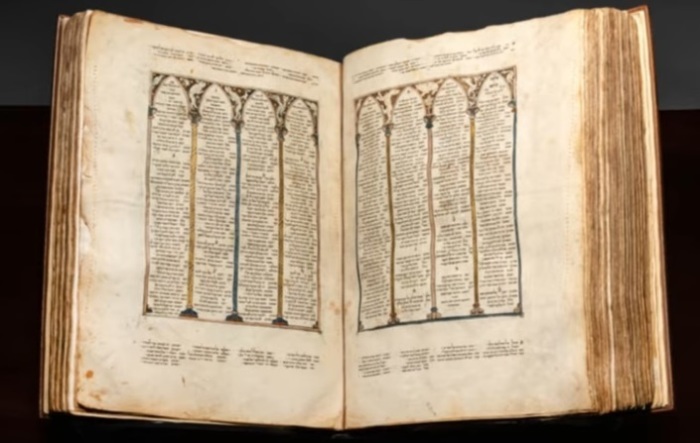
A 14th-century Bible with Jewish, Islamic and Christian artistic influences that sold for $6.9 million at auction last year is on display at the National Library of Israel in Jerusalem.
The Shem Tov Bible, purchased by Terri and Andrew Herenstein in 2024 when sold by Sotheby’s auction house in New York, is being displayed at the National Library of Israel on a long-term loan.
Unveiled on May 8, the piece went on display as part of the “A Treasury of Words” exhibition in the William Davidson Permanent Exhibition Gallery, according to an announcement from the National Library of Israel.
Chaim Neria, curator of the Haim and Hanna Solomon Judaica Collection at the National Library of Israel, said the Shem Tov Bible “represents the pinnacle of biblical and kabbalistic scholarship in the medieval period.”
“Its addition to the NLI collection provides an unparalleled resource for studying the development of the Masorah, and Jewish textual and artistic traditions, in particular those of Spain,” Neria added.
“A significant aspect of the codex is its observance of the Sefer Tagei, a traditional guide outlining the scribal practices required for writing sacred texts,” the curator explained. “The surrounding notations reference earlier, now-lost documents, specifically the Hilleli Codex of 600 CE. The Shem Tov Bible thus allows modern scholars to study traditions that have all but vanished from the historical record.”
Rabbi Shem Tov ben Abraham Ibn Gaon, who created the Shem Tov Bible, completed it in 1312 in Spain. Ibn Gaon was a scholar of Jewish law and mysticism, and, according to the National Library of Israel, the manuscript “reflects the intellectual and spiritual vitality of Sephardic Jewry at that time.”
After completing the manuscript, Ibn Gaon immigrated to the Land of Israel in 1315, where he continued his scholarly and spiritual work until his death in 1330.
The codex is believed to have remained in the Middle East for centuries before it arrived in North Africa in the 17th century, where it was thought that the codex possessed mystical powers, such as easing childbirth.
Collector David Solomon Sassoon eventually acquired the manuscript in the 20th century and had it rebound. In 1984, the owners of a prominent European Judaica collection purchased it. In 1994, Swiss collector Jaqui Safra bought it, and then the Herensteins acquired it at auction three decades later, before the manuscript made its way to the National Library of Israel.
“Receiving this manuscript, especially at the time of Shavuot, which celebrates the giving of the Torah, is profoundly significant,” said Sallai Meridor, chairman of the National Library of Israel.
“Having traveled from Spain to Jerusalem, Baghdad, Tripoli, London and Geneva, the Shem Tov Bible has come full circle and is now back home, returning to the very place where Rabbi Shem Tov ben Abraham Ibn Gaon lived and intended for it to be, in the land of Israel, and now in Jerusalem,” Meridor added. “We are grateful to the Herenstein family for turning what might otherwise have been a dream into a reality.”
In a statement, the Herenstein family described the Shem Tov Bible as “a unique cultural artifact, embodying the scholarship, calligraphic precision, and artistic excellence that characterized the best of medieval Jewish bookmaking.”
“We are delighted to know that the Shem Tov Bible is incorporated into the Library’s permanent exhibition of its greatest treasures, and equally delighted that the manuscript will be digitized to the highest standard, making it available worldwide, for study, research, or to simply enjoy its beauty.”
According to an August 2024 Smithsonian Magazine report, the Shem Tov Bible’s references to the Hilleli Codex, a famous copy of the Hebrew Bible created in the seventh century, is part of what makes it valuable. The Hilleli Codex was used as a model for Hebrew Bibles made between the 13th and 15th centuries; however, the magazine reported that the codex is now considered lost.
Samantha Kamman is a reporter for The Christian Post. She can be reached at: samantha.kamman@christianpost.com. Follow her on Twitter: @Samantha_Kamman


















